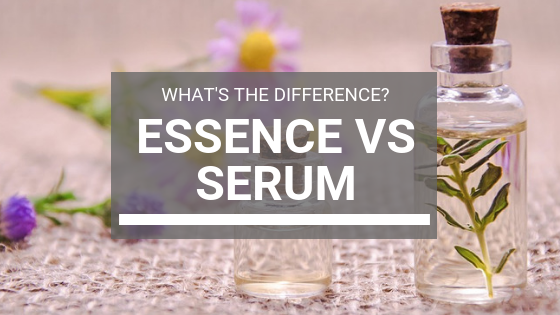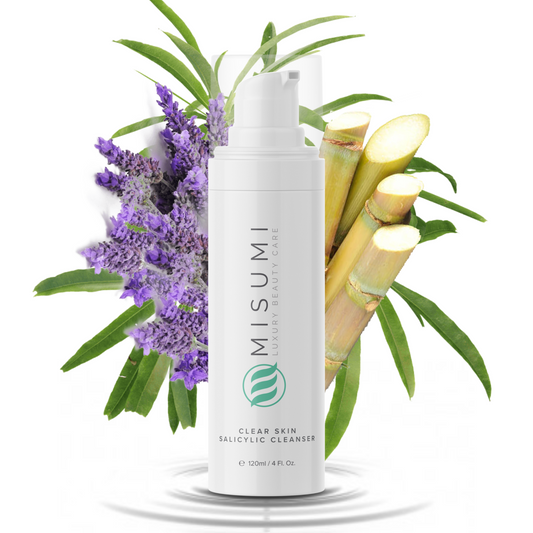If you’re a skincare junkie who wants to know everything about perfecting your skincare routine, including tips and tricks for a flawless look, you must have read plenty of articles about the benefits of using serums and essences in your everyday skincare regimen.
There’s no doubt that these products can benefit your skin. But the problem is that these terms are often used interchangeably, which might make you ask, “Isn’t all of this the same? Do I really need all of this?” Especially if you're using great skincare products already.

Don’t worry - we’ll break down all the differences between serums and essences, look at the similarities, discuss what’s better, and even address the argument that there’s no essential difference (pun intended).
All you need to do is keep reading. We're confident that by the end of this article, you’ll understand how to perfect your personalized skincare routine and get the clear and glowing skin you deserve.
What is Essence?

We can’t start without mentioning the Korean skincare routine and its influence on western culture over the past few years. Korean skincare routines have up to 10-12 steps, and Korean essences are right at the heart of them. In fact, Korean women have been using it for years.
Essence is a watery substance, lightly concentrated with active ingredients that provide hydration. It brings out your inner glow and helps to even out your skin, both in tone and texture, eliminating dark spots.
Essence soothes skin at the cellular level, accelerating natural turnover and encouraging a smoother, healthier complexion. The ingredients will vary based on the brand, your skin type, and your preferences. Because it’s so watery and light, it will evaporate quickly, but that’s perfectly normal. Try it, and you'll soon see why every K beauty routine uses this essential step.
How to Use Essence

You usually use essence after cleansing and toning the skin but before moisturizing. So, after you’ve carefully cleansed your skin and let the toner absorb, you can apply the essence. It’s important to note that essence feels and looks like a hydrating toner, but it’s not supposed to be a substitute for it.
Take a cotton ball and apply the essence evenly on your whole face. Essence hydrates your skin, so don’t pat it dry! Wait a couple of minutes for your face to dry completely, and then continue with your skincare routine.
If you only use an essence, finish your skincare routine with a good moisturizer. Look for one with hyaluronic acid to lock in the skin's moisture. But if you decide to use a serum too, apply it right after the essence. (Keep your eyes peeled - there's more to come on that!)
What is Serum?

Serums have a gel-like consistency. They're highly concentrated with powerful ingredients to help the skin get rid of wrinkles, fine lines, discoloration, and hyperpigmentation.
Serums are used to rejuvenate the skin at a cellular level and can work on a wide range of skin health factors simultaneously. They provide vitamins, antioxidants, peptides, and enzymes, among other beneficial nutrients, which fight off free radical damage, skin pigmentation, aging signs, acne, and scarring.
Usually, you can tell the difference just by feeling them; serums are heavier and thicker than essences. Despite this, they’re still relatively lightweight and absorb well. They deliver beneficial nutrients and hydration to the deepest layers of the skin, where moisturizers can’t penetrate.
Depending on the brand, some serums can be greasy. The thicker and greaser the serum, the higher the concentration of active ingredients. This is important for many people because delivering a high concentration of active ingredients can successfully target specific skin concerns.
How to Use Serum

The sacred rule of skincare is always to apply the lightest products first (such as serums) and slowly make your way toward heavier ones (such as moisturizing creams.) With this in mind, the serum comes fourth, after the toner.
Most serums come in ‘dropper’ bottles or have pumps that let you apply a few drops of the concentrated formula on your fingertips. This way, you can gently spread the product evenly on your whole face. Use a circular motion to gently massage it into the skin for a deeper delivery of ingredients. You can also use a cotton pad if you don't want to use your finger.
Applying more serum to your face doesn’t mean more benefits. Serums come in small bottles because a few drops are more than enough to reap the rewards. Focus on using serum regularly and frequently rather than slathering on a large amount once in a blue moon.
Depending on your preferences, skin problems, and type, you can find a good-quality combination of ingredients that will help tackle specific issues. Serums often contain vitamin C, HCA, BHA, and AHAs.
Key Differences and Similarities

So, now that you know all about these amazing skincare products, it's time to break down the differences between them.
Texture and Concentration
It's easy to separate these two products by their texture. Essences are typically more watery. They’re light and gentle with a lower concentration of active ingredients. This means it's safe to apply essences if you have sensitive skin.
An essence may contain one or more active ingredients, but it probably won’t be as concentrated as a serum.
Order of Application
Since facial essence has a watery texture, it should always come before the serum. But don't let the watery consistency of this skincare product fool you! Don't substitute your toner with this product. They may look similar, but toners and essences have individual formulas, act differently on the skin, and are associated with different benefits.

Essence may look like a good, hydrating toner, but it’s more similar to a serum. Because of this, apply the essence right after the toner and before the serum. It will evaporate quickly, leaving more time for the final steps of your routine.
Serums are thicker and should be applied after you’ve used essence. Depending on the formulation, they can be more or less greasy with a lot of active ingredients, which means it will take a little while before they absorb into the skin.
Some types might make your skin smooth and make you think you don’t need to apply a moisturizer afterward. However, using a moisturizer after applying a serum will lock in the serum’s anti-aging actives and nutrients.
Don't apply an essence, moisturizer, then a serum! This is because the moisturizer will create a barrier between the skin’s pores and the new product, preventing absorption. In other words, you won’t get any benefits from the serum. If you're using both skincare products, serum application should always come second.
Skin Type Affinity

Both serum and essence are suitable for all types of skin. However, since essence is more lightweight and less concentrated, it might work better for sensitive skin or oily skin. It has fewer active ingredients, meaning it can penetrate deeper and provide hydration without causing irritation.
A good serum works well for all types of skin but is especially beneficial for dry, problematic, and combination skin. It’ll also help with loose skin, brown spots, wrinkles, and even scarring.
You can always use both products if your skin allows it. Applying a cleanser, toner, essence, serum, and moisturizer might be too much for some people.
Benefits

When it comes to the advantages of adding a good serum or an essence to your daily skincare routine, both products share the same benefits and work similarly on the skin.
Hydration
People with dry and damaged skin know the struggle of maintaining moisture. Facial essences and serums can change that. These products are known for their ability to penetrate deep into the skin, improve texture, and give your face a hydrated glow and a youthful look.
One of their most used ingredients is hyaluronic acid. This active ingredient works by trapping the skin's natural water levels and ensuring it receives proper hydration. Don't let the name "acid" put you off. Hyaluronic acid is found naturally in our bodies and is completely safe. It's used in many skincare products.
Anti-Aging Properties
One of the most common ingredients found in facial essences and facial serums is vitamin C, which plays a great role in preventing the symptoms of aging skin. It works by aiding collagen production and boosting the skin’s immunity.

With time and regular use, you'll also notice your spots fading and your skin tone becoming even.
Acne and Scarring
Serums and essences come packed with many antioxidants, which scavenge free radicals and protect the skin from the damaging effect of oxidative stress. Combine this with powerful anti-inflammatory ingredients, like zinc or aloe vera, and you have a potent tool for fighting acne, scarring, and dark spots.
They can help you prevent redness, breakouts, and inflammation. They're a great addition to your morning or evening skincare routine.
The “There’s No Difference” Argument

So, by now, we’ve established that both essence and serum deliver active ingredients to the skin. Choosing the right one is all about your personal preference and how your skin reacts to the formula.
Because there are a lot of brands and a massive amount of different formulas with different combinations of ingredients (ranging from mild to very highly concentrated), some people believe the differences between essences and serums are becoming negligible.
You can find serums that are lighter and less concentrated than certain essence products, and vice versa. You can also find them for all skin types and common skin issues. Both products work to deliver similar benefits as well.
So, do we really need to make such a distinction?
Yes! It’s good to know how to separate them, so you know which one to buy for your skin.

Should You Use Essence And Serum Together?
It's unlikely you'll experience a negative reaction from using both products at the same time. But the thing is, using both can be redundant, meaning you won’t get any additional benefits. Instead, invest time and energy into finding the perfect match for your skin, so you don’t overwhelm it with too many products.
However, some problematic skin types might look and feel better after applying both an essence and a serum.

If your skin is sensitive, start by using an essence. After a month or two, you can switch to a milder and gentler serum to see how your skin reacts. Observe your skin for the results. If you still feel like you need a stronger product, you can try both and see if that’s best for you.
Essence VS Serum: Which is Better?
Essence will be better for some people, while serum will be best for others. It really depends on your skin type and specific skin problem.
If you have a specific skin problem you’re concerned about, look at the product’s ingredient label to see if there’s anything you should avoid. As mentioned, if you have sensitive or dry skin, try essence first and see how it goes. But if you have oily and acne-prone skin, go for a more concentrated serum with potent ingredients.
The Bottom Line

Although essence is a relatively new skincare product, it’s rapidly gaining popularity and has earned a permanent spot in the daily skincare routines of many beauty enthusiasts. This is because it provides hydration, keeps the skin glowy and shiny, improves uneven texture, helps brighten your complexion, and reduces visible signs of aging to give you younger-looking skin.
Alternatively, serum will provide a more concentrated approach to battling wrinkles, discoloration, hyperpigmentation, and other common skin issues.
Although the benefits are similar for each type of product, their textures, formulations, and concentrations make them suitable for different skin types and conditions.
By using the guidelines above, you can decide whether it's best to try serum or essence.
References
Efficacy and Tolerability of a Facial Serum for Fine Lines, Wrinkles, and Photodamaged Skin
Enhanced Efficacy of a Facial Hydrating Serum in Subjects with Normal or Self-Perceived Dry Skin









